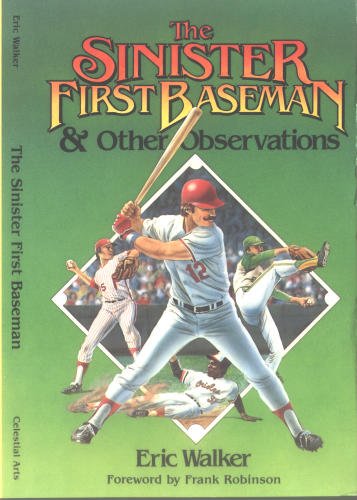At present, there are 13 used copies of Eric Walker’s oddly titled, out-of-print 1982 baseball-themed paperback, The Sinister First Baseman & Other Observations, on sale from Amazon sellers, and the cheapest one, in merely “Acceptable” condition, goes for $104.96. Who, exactly, is Eric Walker and why does he have so much value for so few people?
There were always those who suspected that baseball’s conventional wisdom was not so wise, but in the 1970s, Walker, a Bay Area baseball fan birthed the idea of Moneyball before Sandy Alderson or Billy Beane had entered the game. Even he, however, had an important precursor. From “The Forgotten Man of Moneyball,” Walker’s 2009 Deadspin article, a passage about his inspiration:
But who am I, and why would I be considered some sort of expert on moneyball? Perhaps you recognized my name; more likely, though, you didn’t. Though it is hard to say this without an appearance of personal petulance, I find it sad that the popular history of what can only be called a revolution in the game leaves out quite a few of the people, the outsiders, who actually drove that revolution.
Anyway, the short-form answer to the question is that I am the fellow who first taught Billy Beane the principles that Lewis later dubbed ‘moneyball.’ For the long-form answer, we ripple-dissolve back in time to San Francisco in 1975, where the news media are reporting, often and at length, on the supposed near-certainty that the Giants will be sold and moved. There sit I, a man no longer young but not yet middle-aged, a man who has not been to a baseball game — or followed the sport — for probably over two decades, but a man who in childhood used to paste New York Giants box scores into a scrapbook, and who remembers, dimly but fondly, such folk as Whitey Lockman and Wes Westrum.
Carpe diem, I think.
With my lady, also a baseball fan of old, I go to a game. We have a great time; we go to more games, have more great times. I am becoming enthused. But I am considering and wondering — wondering about the mechanisms of run scoring, things like the relative value of average versus power. Originally an engineer by trade, I am right there with Lord Kelvin: ‘When you cannot measure it and express it in numbers, your knowledge is of a very meagre and unsatisfactory kind.’ I fiddle with some numbers; but I vaguely remember Branch Rickey’s work, the cover story in Life magazine for Aug. 2, 1950, [ed. note: it was actually 1954 and not a cover story] and think that I may not need to reinvent the wheel. I go to the San Francisco main library, looking for books that in some way actually analyze baseball. I find one. One. But what a one.
If this were instead Reader’s Digest, my opening of that book would be ‘The Moment That Changed My Life!’ The book was Percentage Baseball, by one Earnshaw Cook, a Johns Hopkins professor who had consulted on the development of the atomic bomb. Today, when numerical analysis of baseball performance is a commonplace, it is hard to grasp how revolutionary, even shocking, were the concepts Cook was developing (Rickey’s work, which had quickly dropped off everyone’s radar, notwithstanding). The book was, and remains, awe-inspiring.•
Tags: Billy Beane, Earnshaw Cook, Eric Walker, Sandy Alderson

